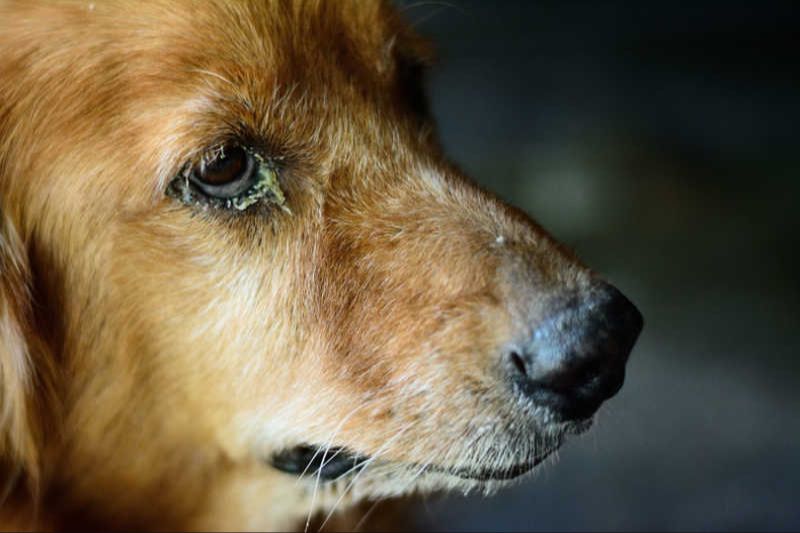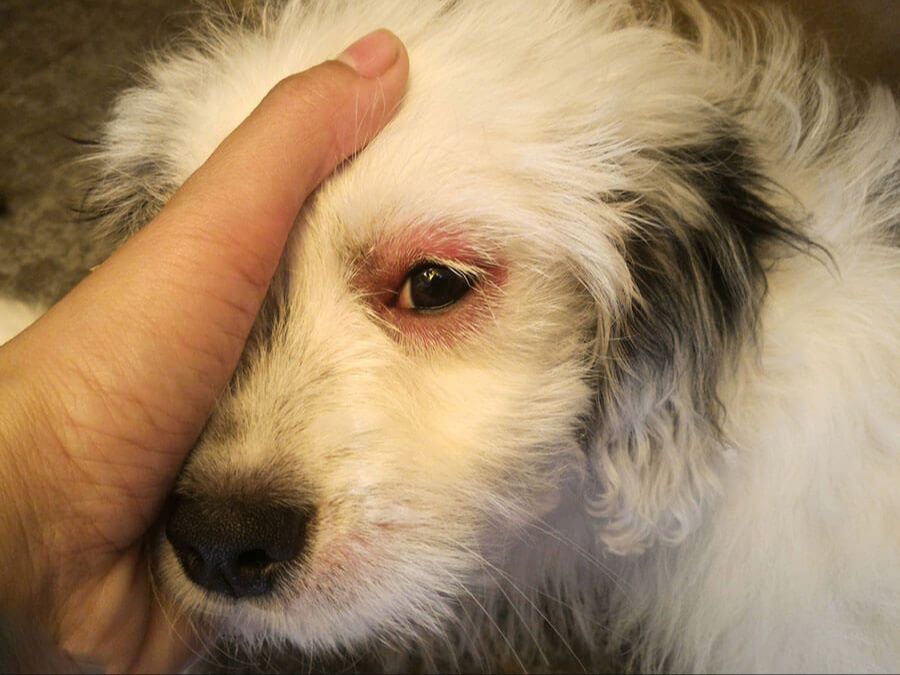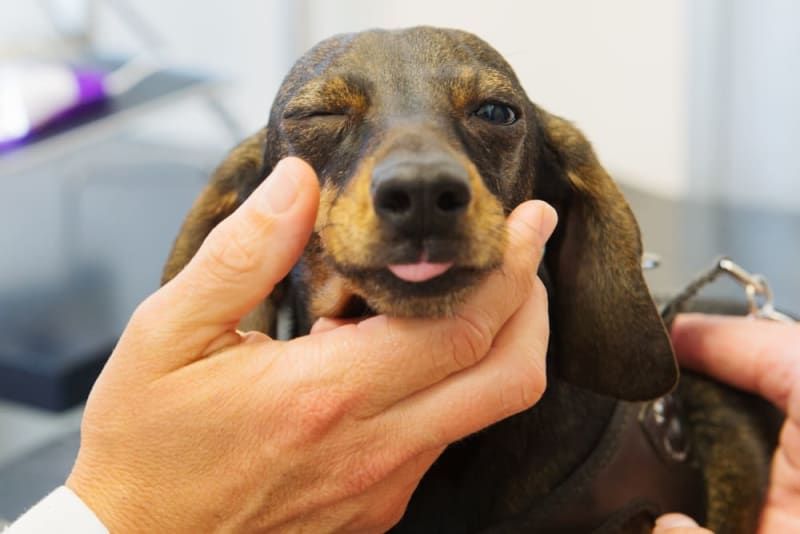Introduction
Conjunctivitis refers to inflammation of the conjunctiva, which is the membrane lining the inner eyelid and front part of the eyeball. It is a common eye condition in dogs that causes redness, swelling, and discharge from the eye. Conjunctivitis can affect one or both eyes, and left untreated, can lead to pain, impaired vision, and even permanent blindness.
There are several possible causes of conjunctivitis in dogs, including infections, allergies, foreign bodies, and eye trauma. Signs include redness, itching, swelling, and discharge, which may be clear, green, yellow, or contain mucus or pus. Conjunctivitis ranges in severity from mild to severe.
While some mild cases may resolve on their own, most require veterinary treatment with prescription eye medications. Proper treatment is important to relieve discomfort, fight infection, reduce swelling, and prevent vision loss. With prompt treatment and care, the prognosis for conjunctivitis in dogs is generally good.
Symptoms
The most common symptoms of conjunctivitis in dogs include redness, swelling, and discharge from the affected eye(s) 1. The whites of the eyes often appear reddened or pink. There may also be swelling around the eye area. Discharge from the eye is typically yellow or greenish in color, and can be watery, thick, or mucus-like. This discharge may cause matting or crusting around the eye. Other possible symptoms are squinting, blinking excessively, pawing at the eye, sensitivity to light, and watery eyes 2.
Causes
Conjunctivitis in dogs can be caused by a variety of factors, including:
Infections
Infections are a common cause of conjunctivitis in dogs. Viral infections such as canine distemper virus or canine herpesvirus can lead to inflammation of the conjunctiva (VCA Animal Hospitals). Bacterial infections from bacteria like Staphylococci can also cause conjunctivitis, either as a primary infection or secondary to another condition that weakened the eye’s defenses.

Allergies
Allergies are another frequent cause of conjunctivitis in dogs. Allergens like pollen, dander, dust mites, or mold spores can trigger an allergic reaction affecting the conjunctiva. This is known as allergic conjunctivitis.
Foreign Objects
Foreign objects like dirt, dust, or eyelashes can become lodged in the eye and physically irritate the conjunctiva, leading to inflammation. Grass seeds are a common foreign object that can get stuck under eyelids.
Diagnosis
If you notice symptoms of conjunctivitis in your dog, it’s important to take them to the veterinarian for a proper diagnosis. The vet will perform a full ocular exam to check for signs of inflammation, discharge, or other abnormalities. They may use a fluorescein stain test to check for ulcers on the surface of the eye that could be causing pain and irritation. This involves putting a special dye in the eye that illuminates any damage under a blue light.

The vet will also want to understand the full history of symptoms and any potential exposure your dog may have had to irritants, allergens, or infectious agents. Based on the exam and history, the vet can determine whether the conjunctivitis is bacterial, viral, allergic, or due to some other cause. Getting an accurate diagnosis will allow the vet to prescribe the appropriate treatment (https://www.bluecross.org.uk/advice/dog/health-and-injuries/conjunctivitis-in-dogs).
Treatment
Treatment for conjunctivitis in dogs focuses on addressing the underlying cause and reducing inflammation. Common treatments include:
Antibiotics: Topical antibiotic eye drops or ointments containing gentamicin, tobramycin, oxytetracycline, or ciprofloxacin are commonly prescribed to fight bacterial infections causing conjunctivitis (VCA Animal Hospitals, PetMD). Antibiotics help kill pathogenic bacteria and allow the eye to heal.
Anti-inflammatories: Steroid eye drops containing prednisolone or dexamethasone may be prescribed to reduce inflammation associated with conjunctivitis. Reducing inflammation can relieve discomfort and promote healing (PetMD).
Flushing: Your veterinarian may recommend flushing the eye with a sterile saline solution to help wash away discharge, debris, and irritants. This can provide relief and keep the eye clean while it heals (Small Door Veterinary).
Home Care
There are some simple home care steps you can take to help relieve your dog’s conjunctivitis symptoms and keep the eye clean while treatment runs its course:
Apply warm compresses to the affected eye several times a day. This helps loosen and remove eye discharge and provides comfort. Use a clean washcloth soaked in warm water. Gently hold the warm compress against your dog’s eye for a few minutes at a time.

Gently clean around the affected eye to remove any discharge or crust that has accumulated. Use a separate clean washcloth dampened with warm water or an eyewash solution recommended by your vet. Wipe from the inside corner of the eye outwards. Be very gentle and take care not to touch the eyeball directly.
Your vet may prescribe antibiotic eye drops or ointment to use at home. Be sure to follow instructions carefully. You may need to apply them several times per day.
Prevention
There are some steps you can take to help prevent conjunctivitis in dogs:
Keep your dog’s eyes clean. Gently wipe away any discharge daily with a soft, damp cloth. Avoid using contact lenses or solutions not made for pets.
Avoid exposing your dog to irritants. Things like cigarette smoke, dust, pollen, or air pollution can irritate your dog’s eyes and make them prone to conjunctivitis. Try to keep your dog away from these irritants.
Wash bedding frequently using gentle detergents. Bacteria and other irritants can collect on bedding.
Don’t let your dog swim in dirty water, which may contain bacteria. Opt for chemical-free clean water sources.
Keep face and eyes trimmed. Long hair can trap debris next to eyes.
Use eye drops proactively. Your vet may recommend non-prescription eye drops to prevent dry eye or irritation in breeds prone to conjunctivitis.
Strengthen their immunity. A diet rich in antioxidants can help your dog better resist infections. Vitamin C and omega fatty acids support eye health.
Avoid sharing toys between dogs, which spreads bacteria. Disinfect toys regularly.
Prognosis
With appropriate treatment, the prognosis for canine conjunctivitis is usually good. Bacterial and viral conjunctivitis often resolve within 1-2 weeks when treated properly (https://www.petmd.com/dog/conditions/eyes/c_dg_conjunctivitis). However, some potential complications to be aware of include:
- Corneal scarring or ulceration if the conjunctivitis is not treated promptly
- Vision loss if the infection spreads deeper into the eye
- Recurrence of symptoms if the underlying cause is not addressed
It’s important to follow up with the veterinarian as recommended to monitor your dog’s improvement. Notify the vet right away if symptoms worsen or fail to get better within a few days of starting treatment. With prompt care, most cases of conjunctivitis resolve without any lasting eye damage.
When to See a Vet
Conjunctivitis can be a serious condition if left untreated. It’s always a good idea to consult your veterinarian or schedule a vet visit if your dog develops symptoms of conjunctivitis.

You should bring your dog to the vet right away if their conjunctivitis symptoms are severe or persist beyond a couple days with home treatment. Seek prompt veterinary care if there is significant eye discharge, swelling, or your dog seems to be in pain or uncomfortable.
Some signs that indicate you should take your dog to the vet for conjunctivitis include:
- Persistent conjunctivitis lasting over 2-3 days with home treatment
- Excessive tearing, discharge, or mattering around the eyes
- Squinting, pawing at the eye, or other signs of eye pain/discomfort
- Cloudiness, haziness, or changes to the cornea or surrounding tissue
- Eyelid swelling, redness, irritation, or lesions
- Any eye injury, such as a scratch or puncture wound
- Ocular bleeding or bloodshot eyes
- Vision impairment or changes in the pupil
- Swelling or infection spreading beyond the eye
It’s important to have a vet examine the eye and determine the cause of conjunctivitis. They can prescribe medicated eye drops, ointments, oral medication, or other treatment tailored to the underlying condition. Prompt treatment from a vet can help prevent complications and vision damage.
Conclusion
Conjunctivitis is a common eye condition in dogs that causes redness and inflammation of the eye. While some mild cases may resolve on their own, it’s important to have your dog seen by a veterinarian, as most cases of conjunctivitis require treatment with prescription eye drops or ointments. Left untreated, conjunctivitis can cause significant pain, vision problems, and damage to the eye. With proper diagnosis and prompt treatment under veterinary guidance, most dogs recover fully from conjunctivitis. Keeping your dog’s eyes clean and avoiding potential irritants can help prevent conjunctivitis. Watch for any eye redness, discharge, squinting, or pawing at the eyes, and contact your vet right away if you observe these signs of conjunctivitis in your dog.